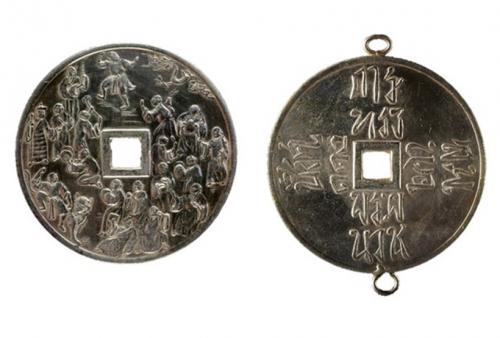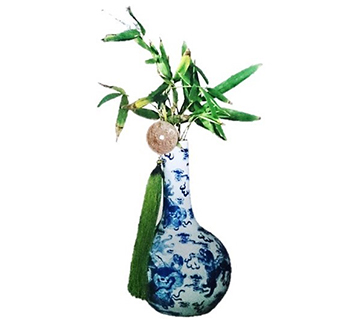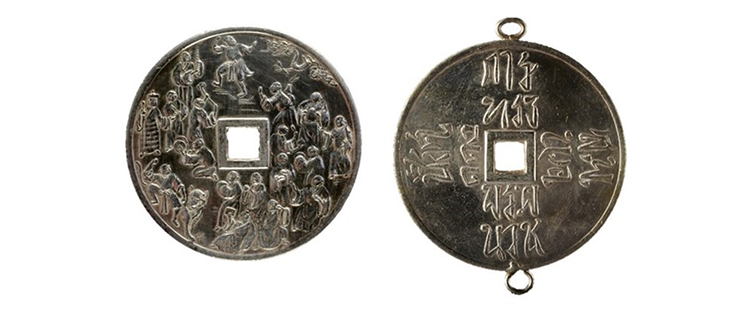Buddhist doctrine has been a main pillar of life for Thais for generations as can be seen in traditional Thai customs and ceremonies. Ordination ceremony is one of the important ceremonies in Buddhism since the period of Buddha because according to old custom, the temple is a place to learn how to read and write; therefore entering monkhood also means education.
During early Rattanakosin period, seeing his eldest son - Prince Maha Vajirunhisreaching an appropriate age, King Rama V commissioned a royal ordination ceremony on the occasion that the prince would be sent to study Buddhist doctrine as required by the royal tradition maintained since Ayutthaya period.
The Royal Ordination Ceremony of the Crown Prince Maha Vajirunhis
The Crown Prince Maha Vajirunhis underwent the royal tonsure ceremony in 1890 Common Era. Later on 10 September 1892 when the Crown Prince was 14 years of age, the King granted an ordination ceremony for the Crown Prince with the purpose that the Crown Prince receive religious education as a novice monk as required by the royal tradition. The royal ordination ceremony took place at Wat Phra Si Rattana Satsadaram with in the Royal Palace. The king invited 20 high-ranking monks, including the Supreme Patriarch, Somdet Phra Rachakhana, and Phra Racha Khana, as well as other members of the royal family to attend the ceremony. In this occasion, the Supreme Patriarch was the chair, and also the preceptor of the ceremony. The Crown Prince then went to reside at Wat Bowonniwet Vihara for five months before resigning from monkhood.
The Royal Commission of the Medals
King Rama V commissioned a production of mint medals to commemorate the royal ordination of the Crown Prince Maha Vajirunhis which was a grand ceremony attended by the royal family, high court of officials as well as government officials; all full-decorated. In the ceremony, a Chinaware table-setting competition was held by order of the king in order to give the royals, the nobles, and government officers an opportunity to socialize. The tables used for competition were set along the balcony of the Ubosot building of Wat Phra Si Rattana Satsadaram. The prize of the competition was medals minted for this royal ordination. The medals are called Rian (coin) Jab Poey. The name derives from a term in a Chinese dialect (Shíbā Luóhàn in Mandarin), meaning eighteen arhats, the image of which appears on the medals. The medals were made of gold-plated silver, silver, and copper, and said to have been blessed in a holy ceremony chaired by the Supreme Patriarch.
Chinaware table-setting competition
The medals minted for the royal ordination of the Crown Prince Maha Vajirunhis
Front An image of 18 arhats, the original followers of the Buddha who have attained Enlightenment according to Mahayana Buddhism, collectively called ‘Shíbā Luóhàn:
The first arhat is called Pindolabharadrāja. His distinctive characteristic is that his body is so thin his ribs are visible. He appears in the images in standing and sitting position, with a book in one hand, an alms bowl in another, or both hands holding a book, or hands resting on both knees. Sometimes a cane is seen on the right-hand side.
The second arhat is called Jiānuòjiā Fácuō Kanakavatsa. He is especially well-versed in Buddhist doctrine. His image is of a monk sitting with his right foot on the floor, his right hand on his knee, his left hand rested on the palm of his left foot.
The third arhat is called Jiānuòjiā Bálíduòshé Kanakabharadrāja. His image is of an old man with long hair, sitting with left foot lifted, his right hand rested on his knee, his left hand on this ear.
The fourth arhat is called Sūpíntuó. He reached the enlightenment stage at 120 years old. His image is of an old man meditating, with one hand holding a book roll. Sometimes he is pictured as sitting with an alm’s bowl and an incense bowl by his side, with his left hand holding a book, his right hand doing a mudra pose, namely touching the tip of index finger with the tip of the thumb, which is a symbol of enlightenment. Additionally, sitting with both hands open is also a common position.
The fifth arhats is called Nuòjùluó Nakula. His distinctive character is his fondness of solitude. His image is presented as sitting with one feet down, with open hands, accompanied by a mongoose, or a child; or there’s a three-legged frog under his armpit.
The sixth arhat is called Bodhidharma. According to a legendary tale, he is believed to have been a relative of Buddha; some says he was of noble descent. He is mostly pictured accompanied by a tiger, implying his triumph over tigers. Sometimes he is represented as a monk with long eyebrows, unaccompanied.
The seventh arhat is called Kālika. He was worshipped by King Bimbisara. On the medal, he was pictured as opening a book roll, or meditating, with one hand holding a leaf. Other representation of him is as an old monk touching his floor-length eyebrows; or holding cymbals.
The eight arhat is called Fáshéluófúduō Vijraputra. His distinct features are the great amount of body hair, and his visible rib cage. He is pictured sitting with one foot down, holding a stick which was inscribed with holy words; the top of the stick was made into a hole attached with metal rings, the sound of which would scare away animals.
The ninth arhat is called Xūbójiā Gobaka. He is picture as holding a book or a fan. There is an image of a small arhat on his right shoulder or on his right side; his both hands holding prayer beads.
The tenth arhat is called Bàntuōjiā Panthaka. He is pictures as sitting under a tree, holding a book, or meditating with both hands rested together. Sometimes he is pictured as threatening a Naga into an alm’s bowl; or sitting on a lion’s back.
The eleventh arhat is called Luóhùluó Rahula, the son of Buddha. Sometimes he is pictured as having a especially large head, large eyes, and a hooked nose; other times he is pictured as a common man holding Chedis in both hands.
The twelfth arhat is called Nājiāxīnā Nagasena. He is pictured in a sitting position, with his left hand raised at the level of his ear, his right hand resting on his knee.
The thirteenth arhat is called Yīnjiētuó Angida. He is the disciple who has a specially clean and fragrant body. His is pictured as a chubby, smiling monk; however sometimes he is pictured as a very old monk holding a cane, a book, or an alms bowl.
The fourteenth arhat is called Fánāpósī Vanavāsa. His image is presented as sitting in front of a cave, with eyes closed, sometimes holding a book, or doing a mudra pose.
The fifteenth arhat is called āshìduō Asita. His image is of an old monk with long eyebrows, sitting with one foot down, his hands rested on his knees. On his chest is an image of a man.
The sixteenth arhat is called Zhùchá Bàntuōjiā Pantha the Younger. He was the disciple of very low intellect who later was also attained enlightenment. He is pictured as sitting with one foot down. His right hand is holding a cup from which a bird is drinking; his left hand is holding a marble ball.
The seventeenth arhat is called Qìngyǒu Nantimitolo. He has 1,700 disciples, the biggest numbers of disciple than any other arhats. He is presented as riding a dragon, his left hand holding a glass ball.
The last arhat, the eighteenth arhat is called Bīntóulú Pindola . He is a dragon master.
These eighteen monks have attained the absolute truth in Buddhism, and reached the highest enlightened stage of Nirvana; they are called arhats. According to Mahayana Buddhism as practised in China, it is believed that these eighteen arhats have, due to their practises, become sages. They are collectively called 'the Eighteen arhats'.
Back A square-shaped hole is made in the middle of the medal; around it are inscriptions of Thai letters in Chinese style. From top to bottom, it reads ‘the Royal Ordination’. On the right side are initials "ส, พ, บ, ร, อ,”, the abbreviation of ‘the Crown Prince’; the left reads ‘110 Rattanakosin Era’.
The Granting of the Medals
The medals to commemorate the Royal ordination of the Crown Prince Maha Vajirunhis, or Jab Poey Lohan were granted by King Rama V as the prize for the royal table setting competitions. Table setting, both in Thai and Chinese style, became popular because it was used in religious ceremonies, to receive the king during royal ceremonies as well as other important ceremonies. It began in the reign of King Rama III who was especially fond of Chinese arts. Chinese tableware were imported and donated to temples. Chinaware gained immense popularity in the reign of King Rama V. Table setting competitions were held regularly, and medals were given as a prize. This was recorded in the annals regarding the coronation of King Rama IV in 1851 Common Era. The king ordered that the members of the royal family, government officials, and the nobility arrange tables in the royal court and Wat Phra Si Rattana Satsadaram. The production of medals and giving them to the winners of the table setting competition as a prize had been popular since 108 Rattanakosin Era or 1889 Common Era. The competitions were judged by a committee until the king enacted a bill and regulations regarding the selection process in table-setting competitions on 16 November 109 Rattanakosin Era.
In sum, the royal ordination medals were commissioned in the reign of King Rama V to celebrate the royal ordination of the Crown Prince Maha Vajirunhis. On the medals were an image done in Chinese-style according to Mahayana Buddhism. The medals were granted as a prize in the table setting competitions which were held in several important royal ceremonies. They were a symbol of the golden age of table setting competition. Apart from being granted as a prize to the winners of the competition as well as the committee of judges, the medals were also used to decorate the table in competitions. Nowadays, these medals are a rare collectible item. There is a great demand from collectors because the medals have a historic value; they are also an important piece of evidence of Chinese influence on the culture of Siam at the time.




